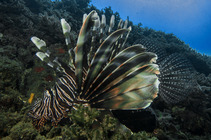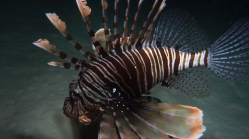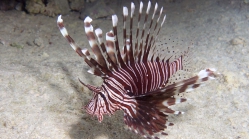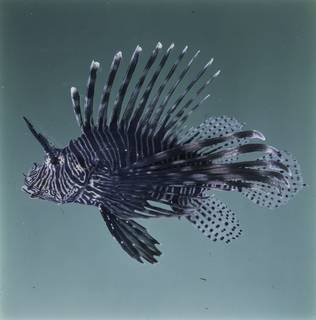
| Intro | | Search taxa | | Browse taxa | | Distributions | | Terminology | | References | | Statistics | | Online sources | | Tutorial | | Log in |
WRiMS taxon detailsPterois miles (Bennett, 1828)
218077 (urn:lsid:marinespecies.org:taxname:218077)
accepted
Species
marine,
(of ) Bennett, J. W. (1828-30). A selection from the most remarkable and interesting fishes found on the coast of Ceylon. <em>London. First Edition.</em> i--viii + 30 unnumbered pp., Pls. 1-30. [details]
Froese, R. and D. Pauly. Editors. (2024). FishBase. Pterois miles (Bennett, 1828). Accessed through: Costello, M. J.; Ahyong, S.; Bieler, R.; Boudouresque, C.; Desiderato, A.; Downey, R.; Galil, B. S.; Gollasch, S.; Hutchings, P.; Kamburska, L.; Katsanevakis, S.; Kupriyanova, E.; Lejeusne, C.; Ma, K. C. K.; Marchini, A.; Occhipinti, A.; Pagad, S.; Panov, V. E.; Poore, G. C. B.; Rewicz, T.; Robinson, T. B.; Rius, M.; Sobczyk, R.; Stern, N.; Turon, X.; Valls Domedel, G.; Verleye, T.; Vieira, L. M.; Willan, R. C.; Yeo Chong Jinn, D.; Zhan, A. (2024) World Register of Introduced Marine Species (WRiMS) at: https://www.marinespecies.org/introduced%20/aphia.php?p=taxdetails&id=218077 on 2024-04-20
Costello, M. J.; Ahyong, S.; Bieler, R.; Boudouresque, C.; Desiderato, A.; Downey, R.; Galil, B. S.; Gollasch, S.; Hutchings, P.; Kamburska, L.; Katsanevakis, S.; Kupriyanova, E.; Lejeusne, C.; Ma, K. C. K.; Marchini, A.; Occhipinti, A.; Pagad, S.; Panov, V. E.; Poore, G. C. B.; Rewicz, T.; Robinson, T. B.; Rius, M.; Sobczyk, R.; Stern, N.; Turon, X.; Valls Domedel, G.; Verleye, T.; Vieira, L. M.; Willan, R. C.; Yeo Chong Jinn, D.; Zhan, A. (2024). World Register of Introduced Marine Species (WRiMS). Pterois miles (Bennett, 1828). Accessed at: https://marinespecies.org/introduced/aphia.php?p=taxdetails&id=218077 on 2024-04-20
Date action by
original description
(of ) Bennett, J. W. (1828-30). A selection from the most remarkable and interesting fishes found on the coast of Ceylon. <em>London. First Edition.</em> i--viii + 30 unnumbered pp., Pls. 1-30. [details]
basis of record Froese, R. & D. Pauly (Editors). (2023). FishBase. World Wide Web electronic publication. version (02/2023)., available online at https://www.fishbase.org [details] additional source Ben Rais Lasram, F.; Mouillot, D. (2008). Increasing southern invasion enhances congruence between endemic and exotic Mediterranean fish fauna. <em>Biological Invasions.</em> 11(3): 697-711., available online at https://doi.org/10.1007/s10530-008-9284-4 [details] Available for editors additional source Azzurro, E.; Stancanelli, B.; Di Martino, V.; Bariche, M. (2017). Range expansion of the common lionfish Pterois miles (Bennett, 1828) in the Mediterranean Sea: an unwanted new guest for Italian waters. <em>BioInvasions Records.</em> 6(2): 95-98., available online at http://www.reabic.net/%5C/journals/bir/2017/2/BIR_2017_Azzurro_etal.pdf [details] additional source Bariche, M.; Torres, M.; Azzurro, E. (2013). The Presence of the invasive Lionfish Pterois miles in the Mediterranean Sea. <em>Mediterranean Marine Science.</em> 14(2): 292-294., available online at https://doi.org/10.12681/mms.428 [details] Available for editors additional source Corsini-Foka, M.; Kondylatos, G. (2015). First occurrence of the invasive lionfish Pterois miles in Greece and the Aegean Sea. <em>Medit. Mar. Sci.</em> 16/3: 692-702. [details] additional source Kletou, D.; Hall-Spencer, J. M.; Kleitou, P. (2016). A lionfish (Pterois miles) invasion has begun in the Mediterranean Sea. <em>Marine Biodiversity Records.</em> 9(1)., available online at https://doi.org/10.1186/s41200-016-0065-y [details] additional source Ounifi-Ben Amor, K.; Ghanem, R. (2016). New record of the lion fish Pterois miles in Tunisian waters. <em>MMS.</em> 17/2: 612-613. [details] additional source Turan, C.; Ergüden, D.; Gürlek, M.; Yağlıoğlu, D.; Uyan, A.; Uygur, N. (2014). First record of the Indo-Pacific lionfish Pterois miles (Bennett, 1828)(Osteichthyes: Scorpaenidae) for the Turkish marine waters. <em>Journal of Black Sea/Mediterranean Environment.</em> 20(2): 158-163. [details] ecology source Looby, A.; Erbe, C.; Bravo, S.; Cox, K.; Davies, H. L.; Di Iorio, L.; Jézéquel, Y.; Juanes, F.; Martin, C. W.; Mooney, T. A.; Radford, C.; Reynolds, L. K.; Rice, A. N.; Riera, A.; Rountree, R.; Spriel, B.; Stanley, J.; Vela, S.; Parsons, M. J. G. (2023). Global inventory of species categorized by known underwater sonifery. <em>Scientific Data.</em> 10(1). (look up in IMIS), available online at https://doi.org/10.1038/s41597-023-02745-4 [details]  Present Present  Inaccurate Inaccurate  Introduced: alien Introduced: alien  Containing type locality Containing type locality
From regional or thematic species database
Introduced species impact United States part of the North Atlantic Ocean (Marine Region) Consumes native species (predator or herbivore) [details]Introduced species management Bahamas part of the North Atlantic Ocean (Marine Region) This suggests at least some mesophotic populations may represent extensions of natural ontogenetic migrations. Interestingly, despite their shallow focus, in many cases culling programs did not appear to alter abundance between depths. In general, we identify widespread invasive lionfish populations on MCE that could be responsible for maintaining high densities of lionfish recruits despite local shallow-biased control programs. [details] Introduced species management Bahamas part of the North Atlantic Ocean (Marine Region): The two culling frequencies we examined therefore seem to offer a poor trade-off between the demonstrated conservation gains that can be achieved with frequent culling and the economy of time and money realized by infrequent culling. Moreover, stochastic events such as hurricanes can drastically limit the effectiveness of culling efforts. [details] Introduced species management United States part of the North Atlantic Ocean (Marine Region) Between July 2010 and April 2017, a total of 6994 Lionfish were removed from the Park, ranging in size from 32 mm to 444 mm total length. The National Park Service (NPS) developed a Lionfish Response Plan, aimed at addressing its impacts in multiple marine parks, that sets forth guidelines for the management of Lionfish within the various NPS units, including collection of Lionfish specimens, cooperation with other entities (e.g., other governmental agencies, non-governmental organizations, and universities) for research, and education of visitors and the public (McCreedy et al. 2012). [details] Introduced species remark United States part of the Gulf of Mexico (Marine Region) Despite a substantially greater sampling effort in 2007–2008 [total of 938,126 m3 of water sampled compared to approximately 144,013 m3 (~15%) sampled in 2014–2015], we collected no lionfish larvae in 2007–2008, whereas in 2014–2015, 76 larvae were collected. The overall mean density in 2014–2015 of 0.4–0.7 lionfish larvae 1000 m-3 is comparable to a number of common reef fish families and is likely beginning to have an ecological impact on plankton constituents. [details] Introduced species remark Bahamas part of the North Atlantic Ocean (Marine Region) Lionfish movement was density dependent, declined at larger body sizes, and depended on seascape structure. Lionfish on continuous reefs moved faster and more often than those on patch reefs, and lionfish in patchy habitats moved farther when patches were closer together. [details] Introduced species vector dispersal in Israeli part of the Mediterranean Sea - Eastern Basin (Marine Region) : Individual release: deliberate release by individuals [details] Introduced species vector dispersal Greek part of the Aegean Sea (Marine Region) Canals: natural range expansion through man-made canals [details] Introduced species vector dispersal in Israeli part of the Mediterranean Sea - Eastern Basin (Marine Region) : Canals: natural range expansion through man-made canals [details] Introduced species vector dispersal Cypriote part of the Mediterranean Sea - Eastern Basin (Marine Region) Canals: natural range expansion through man-made canals (Suez Canal) [details]
To Barcode of Life (338 barcodes)
To Biodiversity Heritage Library (47 publications) To Digital Atlas Of Marine Species & Locations, DAMSL (Red Sea Lionfish) To European Nucleotide Archive (ENA) To FishBase To FishBase images (Pterois miles, Egypt, by Patzner, R.) To GenBank (1205 nucleotides; 281 proteins) To IUCN Red List (Least Concern) To NMNH Extant Collection (Pterois miles FIN033367 Slide 120 mm) To PESI To ITIS |





